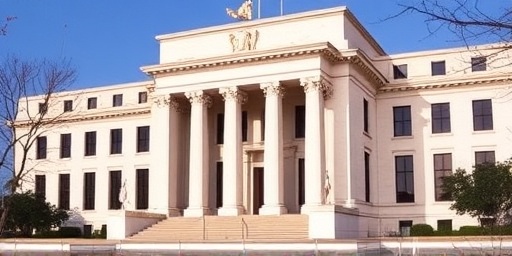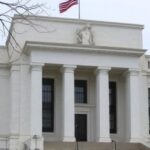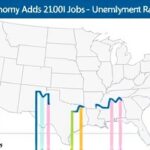In a pivotal move that sent ripples through financial markets, the Federal Reserve has signaled the possibility of an interest rate cut as indicators point to a decelerating U.S. economy coupled with ongoing inflation worries. Federal Reserve Chair Jerome Powell, during a recent press conference following the latest Federal Open Market Committee (FOMC) meeting, emphasized that while inflation remains above target levels, weakening economic data warrants a closer look at monetary policy adjustments. This hint comes at a time when unemployment rates are ticking up slightly and consumer spending shows signs of fatigue, raising questions about the trajectory of the world’s largest economy.
The announcement, though not a firm commitment, has already influenced investor sentiment, with stock indices climbing in anticipation of looser monetary policy. Economists note that such a rate cut could provide much-needed relief to borrowers but might also complicate the battle against inflation, which has hovered around 3% in recent months despite aggressive rate hikes over the past two years.
Fed’s Close Watch on Labor Market Weakness
The Federal Reserve‘s cautious tone stems largely from emerging cracks in the labor market, a cornerstone of the U.S. economy. Recent jobs reports from the Bureau of Labor Statistics revealed that nonfarm payrolls increased by only 177,000 in September, falling short of expectations and marking the slowest growth since early 2021. This slowdown contrasts sharply with the robust hiring surges seen during the post-pandemic recovery, where monthly gains often exceeded 300,000.
Powell highlighted these figures in his remarks, stating, “The labor market is cooling but remains solid overall. However, we are monitoring wage growth closely, as it could fuel inflation if not tempered by softer demand.” Wage increases have moderated to about 4% annually, down from peaks above 5%, but still above the 2% inflation target set by the Fed. This dynamic underscores the delicate balance the central bank is navigating: supporting employment without reigniting price pressures.
Further data from the ADP Employment Report corroborated the official numbers, showing private sector job growth at 152,000 for the same period. Regional disparities are also evident, with manufacturing-heavy states like Michigan and Ohio reporting sharper declines in job openings. The JOLTS report indicated 8.9 million job vacancies in August, a drop from 9.6 million earlier in the year, signaling that employers are pulling back amid economic uncertainty.
Economists attribute this labor market softening to higher interest rates implemented since 2022, which have raised borrowing costs for businesses and dampened expansion plans. As one analyst from Goldman Sachs noted, “The Fed’s rate hikes have successfully curbed the hottest inflation in four decades, but the collateral damage to employment is now becoming apparent.” This sets the stage for potential policy pivots, with markets pricing in a 70% chance of a 25-basis-point cut at the next FOMC meeting in December.
Inflation’s Stubborn Grip Challenges Rate Cut Hopes
Despite the positive signals for a rate cut, inflation remains a formidable hurdle for the Federal Reserve. The Consumer Price Index (CPI) rose 3.2% year-over-year in September, slightly up from August’s 3.1%, driven by increases in shelter costs and energy prices. Core inflation, excluding volatile food and energy, held steady at 3.7%, indicating that underlying price pressures are not abating as quickly as hoped.
The Producer Price Index (PPI) also showed resilience, climbing 2.2% annually, with services inflation particularly sticky at 4.1%. This persistence has led some Fed officials to advocate for patience, with Vice Chair Lael Brainard commenting, “We cannot declare victory over inflation prematurely; doing so risks a relapse that could erode public confidence.” The Fed’s preferred gauge, the Personal Consumption Expenditures (PCE) price index, came in at 2.7% for the headline figure and 2.9% for core in August, still well above the 2% goal.
Global factors are exacerbating these trends. Supply chain disruptions from geopolitical tensions, including the ongoing conflicts in Ukraine and the Middle East, have pushed up commodity prices. Oil prices, for instance, surged 5% in the last month to over $75 per barrel, contributing to higher gasoline costs that directly impact consumer wallets. Domestically, housing inflation remains a thorn, with rent increases averaging 6.5% in major metros, according to Zillow data.
Yet, there are glimmers of progress. Grocery prices, which spiked dramatically in 2022, have stabilized, with food-at-home inflation dipping to 1.2%. Apparel and new vehicle prices have also seen deflationary pressures due to normalized supply chains. Fed economists project that inflation could ease to 2.5% by year-end if energy markets calm, but risks from potential trade wars or weather events loom large.
- Key Inflation Drivers: Shelter (up 5.2%), Energy (up 1.8%), Food (up 2.4%)
- Core PCE Forecast: Expected to fall to 2.6% in Q4 2023
- Fed’s Stance: Data-dependent approach to rate decisions
Wall Street’s Bullish Response to Fed Signals
Financial markets wasted no time reacting to the Federal Reserve’s dovish hints. The S&P 500 rallied 1.5% immediately following Powell’s speech, while the Nasdaq Composite gained 2.1%, buoyed by tech stocks sensitive to interest rates. Bond yields dipped, with the 10-year Treasury falling to 4.1% from 4.3%, reflecting bets on easier monetary policy.
Investors are particularly optimistic about sectors like real estate and consumer discretionary, which have been hammered by high borrowing costs. Mortgage rates, hovering near 7%, could drop to 6.5% with a rate cut, potentially unlocking pent-up housing demand. REITs (Real Estate Investment Trusts) saw a 3% uptick, as lower rates would reduce financing expenses for property developers.
However, not all reactions were uniformly positive. The U.S. dollar weakened against major currencies, sliding 0.8% versus the euro, which could benefit exporters but raise import costs and thus inflation. Commodity markets were mixed, with gold prices climbing to $1,950 per ounce as a safe-haven asset amid rate cut speculation.
Wall Street heavyweights weighed in swiftly. JPMorgan Chase CEO Jamie Dimon cautioned that while a rate cut might stabilize growth, “Persistent inflation could force the Fed into a stop-go policy, unsettling markets further.” Meanwhile, BlackRock’s chief investment strategist suggested that equities could surge another 10% by mid-2024 if the Fed eases without sparking renewed price hikes.
- Immediate Market Gains: Dow Jones up 400 points post-announcement
- Sector Winners: Technology and financials lead the charge
- Volatility Ahead: VIX index spikes to 18, indicating caution
Broader Economic Ramifications for Households and Businesses
For everyday Americans, the prospect of lower interest rates from the Federal Reserve offers tangible relief. Credit card rates, currently averaging 20.5%, and auto loans at 7.2% could see reductions, easing the burden on indebted households. The total U.S. household debt stands at $17.5 trillion, per Federal Reserve data, with revolving debt up 4% year-over-year.
Consumer confidence, as measured by the University of Michigan survey, rose to 68.7 in October from 66.1, partly due to expectations of rate relief. Retail sales grew 0.4% in September, but excluding autos, the figure was flat, suggesting spending is restrained by high prices and rates. Low-income families, hit hardest by inflation, stand to benefit most from cheaper borrowing, potentially boosting discretionary purchases.
Businesses, too, are eyeing the Fed’s moves warily. Corporate borrowing costs have risen, with investment-grade bond yields at 5.5%. A rate cut could spur capital expenditures, particularly in infrastructure and green energy sectors incentivized by the Inflation Reduction Act. However, small businesses report challenges: The National Federation of Independent Business index shows optimism at a two-year low, with 45% citing inflation as their top concern.
Regional impacts vary. Coastal tech hubs like San Francisco may see quicker rebounds through venture funding, while Rust Belt manufacturers grapple with supply costs. The Fed’s regional banks, such as those in Dallas and Atlanta, have reported softer GDP growth estimates—1.8% and 2.1% annualized for Q3, respectively—highlighting uneven recovery.
Quotes from affected parties illustrate the stakes. A small business owner in Ohio shared, “High interest rates are killing our expansion plans; a cut would let us hire again.” On the consumer side, a recent survey by LendingTree found 62% of respondents planning to refinance if rates drop below 6.5%.
Outlook: Navigating Rate Cuts in an Uncertain Landscape
Looking ahead, the Federal Reserve’s next moves will hinge on incoming data, with the November jobs report and October CPI release critical bellwethers. If unemployment climbs above 4.1% or inflation accelerates, the window for a rate cut could narrow. Analysts forecast one to two 25-basis-point reductions by mid-2024, potentially bringing the federal funds rate to 4.75%-5% from the current 5.25%-5.5%.
This path could stabilize the U.S. economy, averting a recession projected by some models at 35% probability. However, global headwinds—such as China’s economic slowdown and Europe’s energy crisis—pose risks to exports and supply chains. The Fed may also coordinate with international peers; the European Central Bank recently paused hikes, aligning with a global easing trend.
For investors and policymakers, the emphasis is on vigilance. As Powell concluded, “Our decisions will be guided by the dual mandate of maximum employment and price stability, ensuring the U.S. economy’s resilience.” With holiday spending season approaching, the interplay between interest rates, inflation, and growth will define the year’s close and set the tone for 2024. Businesses and households alike are bracing for these shifts, hopeful yet cautious about the Federal Reserve’s balancing act.









